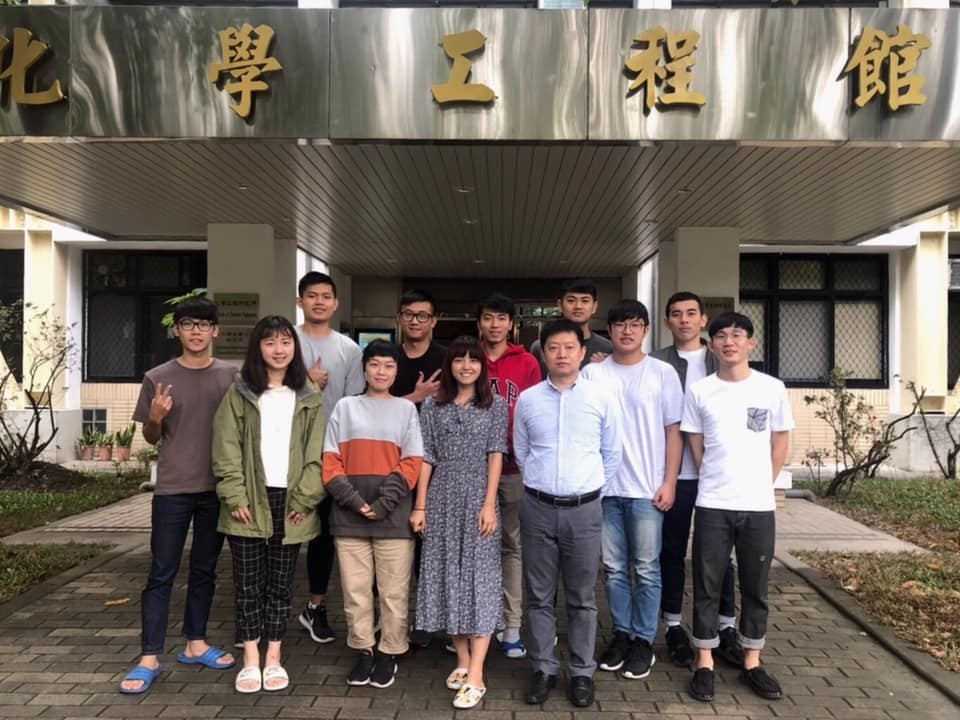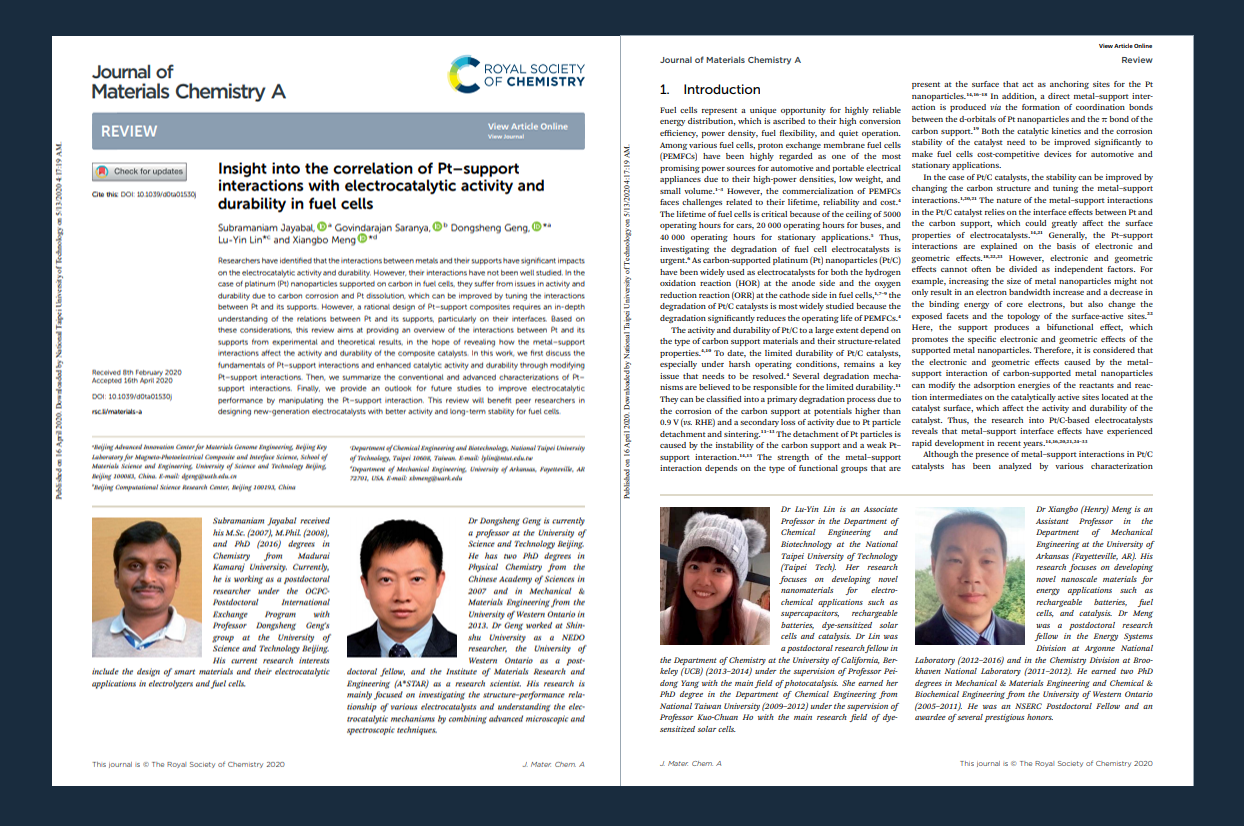Cooperation and exchange with Beijing University of Science and Technology
| Cooperation and exchange with Beijing University of Science and Technology |
|
Associate Prof. Lu-Yin Lin of Chemical Engineering and Biotechnology Thanks to the subsidy for the cooperation project on academic thematic research in the mainland of our school, this laboratory was deeply honored to have the opportunity to cooperate with Professor Geng Dongsheng of Beijing University of Science and Technology last year. This cooperation plan is to develop high-efficiency photocatalysts and electrocatalytic catalysts for water decomposition and organic matter degradation reactions. Through the development of different photocatalysts and the adjustment of experimental parameters, together with testing the efficiency of water decomposition and organic matter degradation, high-efficiency photocatalyst systems can be established. The results of this project were successfully published in two journals in May this year. The first one was published in Journal of Material Chemistry A (impact factor = 10.733; DOI: 10.1039/D0TA01530J) (Figure 2), the main content is to summarize the interaction between Pt and its carrier from experimental and theoretical results, with a view to revealing the metal and carrier How the interactions affect the activity and durability of the composite catalyst. In the past, many documents have summarized that the interaction between the metal and its carrier has a significant influence on the electrocatalytic activity and durability, but the reason for the deeper interaction has not been carefully discussed and unified. For Pt nanoparticles loaded on carbon in fuel cells, due to carbon corrosion and Pt dissolution, they will encounter problems of activity and durability, which can be improved by adjusting the interaction between Pt and its carrier, but Reasonable design of Pt-carrier composite materials requires an in-depth understanding of the relationship between Pt and its carrier. This document first discusses the basic principles of Pt-carrier interactions and methods to enhance catalytic activity and durability by modifying Pt-carrier interactions; secondly, the results of crop and electrical analysis of Pt-carrier interactions. Finally, it provides prospects for future research on manipulating Pt-support interactions to improve electrocatalytic performance. This document anticipates that by designing a new generation of electrocatalysts with better activity and long-term stability of fuel cells, the development in this field will be more rapid and sound. Another collaborative article was published in Materials Science in Semiconductor Processing (Volume 117, October 2020, 105180), which mainly proposes a simple solid-state synthesis method that directly mixes precursor salts to prepare BiVO4 powder. Bismuth vanadate BiVO4 with suitable energy band position and visible light response characteristics has been widely used as an effective photocatalyst for the degradation of organic pollutants and water oxidation, but the solution method for preparing BiVO4 generally needs to go through the processes of dissolution, reaction, crystallization, and drying, More complicated and time-consuming. In this paper, we dope heterojunctions and base treatments on BiVO4 by doping the relevant precursor salts directly in the solid solution. It was found that when 0.1 M NaOH was used to modify BiVO4, the degradation of methylene blue under visible light for 80 minutes could be increased to 81%, mainly due to the relatively rough surface of the bismuth oxide/BiVO4 heterojunction and this sample. On the other hand, under the AM 1.5 solar simulation, the photocurrent density of the BiVO4 electrode co-doped with W and Mo at 1.23 VRHE potential is much higher than that of the BiVO4 electrode under the same measurement conditions (0.33 mA/ cm2), presumably due to the high carrier density caused by heteroatom doping. This result can be mainly attributed to the compatibility between different materials and the harmony between heterojunction and surface roughness, which makes the different photocatalytic performance of heteroatom-doped and alkali-treated BiVO4 for the degradation of methylene blue and water oxidation. The main contribution of this research is to provide a simple solid-state synthesis method to prepare high-efficiency BiVO4 photocatalyst and to modify the BiVO4 photocatalyst in different ways and find that its photoelectrochemical performance in photodegradation and water decomposition has different trends. Another collaborative article was published in Materials Science in Semiconductor Processing (Volume 117, October 2020, 105180), which mainly proposes a simple solid-state synthesis method that directly mixes precursor salts to prepare BiVO4 powder. Bismuth vanadate BiVO4 with suitable energy band position and visible light response characteristics has been widely used as an effective photocatalyst for the degradation of organic pollutants and water oxidation, but the solution method for preparing BiVO4 generally needs to go through the processes of dissolution, reaction, crystallization, and drying, More complicated and time-consuming. In this paper, we dope heterojunctions and base treatments on BiVO4 by doping the relevant precursor salts directly in the solid solution. It was found that when 0.1 M NaOH was used to modify BiVO4, the degradation of methylene blue under visible light for 80 minutes could be increased to 81%, mainly due to the relatively rough surface of the bismuth oxide/BiVO4 heterojunction and this sample. On the other hand, under the AM 1.5 solar simulation, the photocurrent density of the BiVO4 electrode co-doped with W and Mo at 1.23 VRHE potential is much higher than that of the BiVO4 electrode under the same measurement conditions (0.33 mA/ cm2), presumably due to the high carrier density caused by heteroatom doping. This result can be mainly attributed to the compatibility between different materials and the harmony between heterojunction and surface roughness, which makes the different photocatalytic performance of heteroatom-doped and alkali-treated BiVO4 for the degradation of methylene blue and water oxidation. The main contribution of this research is to provide a simple solid-state synthesis method to prepare high-efficiency BiVO4 photocatalyst and to modify the BiVO4 photocatalyst in different ways and find that its photoelectrochemical performance in photodegradation and water decomposition has different trends. International exchange is very helpful to academic development. Through different thinking, different environments, and different research attitudes, new brainstorming, and better innovative research ideas can be generated for each other. In addition, more understanding of the academic environment outside of Taiwan will also enable us to make up for our weaknesses instead of being a frog at the bottom of the well. The cooperation in the coming year will be carried out together with Professor Zhou Dan of the School of Mathematics and Physics, University of Science and Technology Beijing, with the theme of developing energy storage materials and electrolytes for lithium/sodium-ion batteries, and looking forward to more gains in the new year plan. I also hope that as the epidemic slows down, academic exchanges between the two sides will resume. I hope that the 109-year plan will bring relevant plan students to visit Beijing University of Science and Technology. I believe it will be of great help to both sides’ research and students’ horizons. Thank you again for the academic subsidy of the school's inter-school cooperation program. In addition to providing excellent funding, it also provides opportunities for an academic exchange to broaden our academic and life horizons. |
|
Cooperation and exchange with Prof. Geng of Beijing University of Science and Technology and take a photo at the entrance of the Department of Chemical Engineering and Biotechnology |
|
A common journal published in the Journal of Material Chemistry A in May this year |



